The Effects of Lignin on the Thermal and Morphological Properties and Damage Mechanisms after UV Irradiation of Polypropylene Biocomposites Reinforced with Flax and Pine Fibres: Acoustic Emission Analysis
Abstract
1. Introduction
2. Experiments
2.1. Materials, Specimens, and Tensile Testing
2.2. Characterization Methods
2.2.1. True Density Measurement
2.2.2. Thermal Assessment
2.2.3. ATR–FTIR Analysis
2.2.4. Morphological Analysis
2.3. Artificial Weathering
- UV without humidity: The samples were subjected to UV ageing using UVA-340 fluorescent lamps (irradiance at a wavelength of 340 nm) in a QUV/SE ageing apparatus (Q-Lab Co., Westlake, OH, USA). Ageing lasted for two months, with 8 h of UV exposure at an irradiance of 1.55 W/m2 at 60 °C per day.
- UV with humidity: The samples, consistent with those in Condition 1, underwent two months of ageing but included 4 h of water condensation at 50 °C following each UV exposure session at 60 °C.
2.4. Acoustic Emission
3. Results and Discussion
3.1. Morphological Analysis
3.2. True Density Measurement
3.3. Thermogravimetric Analysis
3.4. Differential Scanning Calorimetry Analysis
3.5. ATR–FTIR Analysis
3.6. Acoustic Emission Analysis
4. Conclusions
Author Contributions
Funding
Institutional Review Board Statement
Informed Consent Statement
Data Availability Statement
Acknowledgments
Conflicts of Interest
References
- Jaiswal, C. Biocomposites Market Research Report Information. Available online: https://www.marketresearchfuture.com/reports/biocomposite-market-4433 (accessed on 21 February 2024).
- Ramesh, M.; Rajeshkumar, L.; Sasikala, G.; Balaji, D.; Saravanakumar, A.; Bhuvaneswari, V.; Bhoopathi, R. A critical review on wood-based polymer composites: Processing, properties, and prospects. Polymers 2022, 14, 589. [Google Scholar] [CrossRef]
- Startsev, V.; Lebedev, M.; Khrulev, K.; Molokov, M.; Frolov, A.; Nizina, T. Effect of outdoor exposure on the moisture diffusion and mechanical properties of epoxy polymers. Polym. Test. 2018, 65, 281–296. [Google Scholar] [CrossRef]
- Belec, L.; Nguyen, T.; Nguyen, D.; Chailan, J.-F. Comparative effects of humid tropical weathering and artificial ageing on a model composite properties from nano-to macro-scale. Compos. Part A Appl. Sci. Manuf. 2015, 68, 235–241. [Google Scholar] [CrossRef]
- Chang, B.P.; Mohanty, A.K.; Misra, M. Studies on durability of sustainable biobased composites: A review. RSC Adv. 2020, 10, 17955–17999. [Google Scholar] [CrossRef]
- Dittenber, D.B.; GangaRao, H.V. Critical review of recent publications on use of natural composites in infrastructure. Compos. Part A Appl. Sci. Manuf. 2012, 43, 1419–1429. [Google Scholar] [CrossRef]
- Azwa, Z.; Yousif, B.; Manalo, A.; Karunasena, W. A review on the degradability of polymeric composites based on natural fibres. Mater. Des. 2013, 47, 424–442. [Google Scholar] [CrossRef]
- Frigione, M.; Rodríguez-Prieto, A. Can accelerated aging procedures predict the long term behavior of polymers exposed to different environments? Polymers 2021, 13, 2688. [Google Scholar] [CrossRef]
- Beg, M.D.H.; Pickering, K.L. Accelerated weathering of unbleached and bleached Kraft wood fibre reinforced polypropylene composites. Polym. Degrad. Stab. 2008, 93, 1939–1946. [Google Scholar] [CrossRef]
- Fabiyi, J.S.; McDonald, A.G.; Wolcott, M.P.; Griffiths, P.R. Wood plastic composites weathering: Visual appearance and chemical changes. Polym. Degrad. Stab. 2008, 93, 1405–1414. [Google Scholar] [CrossRef]
- Peng, Y.; Liu, R.; Cao, J. Characterization of surface chemistry and crystallization behavior of polypropylene composites reinforced with wood flour, cellulose, and lignin during accelerated weathering. Appl. Surf. Sci. 2015, 332, 253–259. [Google Scholar] [CrossRef]
- Nasri, K.; Toubal, L.; Loranger, É.; Koffi, D. Influence of UV irradiation on mechanical properties and drop-weight impact performance of polypropylene biocomposites reinforced with short flax and pine fibers. Compos. Part C Open Access 2022, 9, 100296. [Google Scholar] [CrossRef]
- Nasri, K.; Toubal, L. Experimental and numerical investigation of damage and mechanical property retention by bio-composite plastic made with flax or pinewood fiber and aged by exposure to ultraviolet light. J. Build. Eng. 2023, 79, 107899. [Google Scholar] [CrossRef]
- Morin, S.; Dumoulin, L.; Delahaye, L.; Jacquet, N.; Richel, A. Green composites based on thermoplastic starches and various natural plant fibers: Impacting parameters of the mechanical properties using machine-learning. Polym. Compos. 2021, 42, 3458–3467. [Google Scholar] [CrossRef]
- Nasri, K.; Loranger, É.; Toubal, L. Effect of cellulose and lignin content on the mechanical properties and drop-weight impact damage of injection-molded polypropylene-flax and-pine fiber composites. J. Compos. Mater. 2023, 57, 3347–3364. [Google Scholar] [CrossRef]
- Matuana, L.M.; Jin, S.; Stark, N.M. Ultraviolet weathering of HDPE/wood-flour composites coextruded with a clear HDPE cap layer. Polym. Degrad. Stab. 2011, 96, 97–106. [Google Scholar] [CrossRef]
- Bravo, A.; Toubal, L.; Koffi, D.; Erchiqui, F. Damage characterization of bio and green polyethylene–birch composites under creep and cyclic testing with multivariable acoustic emissions. Materials 2015, 8, 7322–7341. [Google Scholar] [CrossRef] [PubMed]
- ASTM D638-22; A. Standard Test Method for Tensile Properties of Plastics. ASTM: West Conshohocken, PA, USA, 2022.
- ASTM G154-23; A. Standard Practice for Operating Fluorescent Ultraviolet (UV) Lamp Apparatus for Exposure of Materials. ASTM: West Conshohocken, PA, USA, 2023.
- Dobah, Y.; Zampetakis, I.; Ward, C.; Scarpa, F. Thermoformability characterisation of Flax reinforced polypropylene composite materials. Compos. Part B Eng. 2020, 184, 107727. [Google Scholar] [CrossRef]
- Le Gall, M.; Davies, P.; Martin, N.; Baley, C. Recommended flax fibre density values for composite property predictions. Ind. Crops Prod. 2018, 114, 52–58. [Google Scholar] [CrossRef]
- Pérez-Fonseca, A.; Robledo-Ortíz, J.; Ramirez-Arreola, D.; Ortega-Gudiño, P.; Rodrigue, D.; González-Núñez, R. Effect of hybridization on the physical and mechanical properties of high density polyethylene–(pine/agave) composites. Mater. Des. 2014, 64, 35–43. [Google Scholar] [CrossRef]
- Vinod, A.; Rangappa, S.M.; Srisuk, R.; Tengsuthiwat, J.; Siengchin, S. Agro-waste Capsicum annum stem: An alternative raw material for lightweight composites. Ind. Crops Prod. 2023, 193, 116141. [Google Scholar]
- Belouadah, Z.; Belhaneche-Bensemra, N.; Ati, A. Characterization of ligno-cellulosic fiber extracted from Atriplex halimus L. plant. Int. J. Biol. Macromol. 2021, 168, 806–815. [Google Scholar] [CrossRef] [PubMed]
- Manral, A.; Bajpai, P.K. Analysis of Natural fiber constituents: A Review. In IOP Conference Series: Materials Science and Engineering; IOP Publishing: Bristol, UK, 2018; p. 012115. [Google Scholar]
- Burhenne, L.; Messmer, J.; Aicher, T.; Laborie, M.-P. The effect of the biomass components lignin, cellulose and hemicellulose on TGA and fixed bed pyrolysis. J. Anal. Appl. Pyrolysis 2013, 101, 177–184. [Google Scholar] [CrossRef]
- Kristanto, J.; Azis, M.M.; Purwono, S. Multi-distribution activation energy model on slow pyrolysis of cellulose and lignin in TGA/DSC. Heliyon 2021, 7, e07669. [Google Scholar] [CrossRef] [PubMed]
- Ahmad Saffian, H.; Hyun-Joong, K.; Md Tahir, P.; Ibrahim, N.A.; Lee, S.H.; Lee, C.H. Effect of lignin modification on properties of kenaf core fiber reinforced poly (butylene succinate) biocomposites. Materials 2019, 12, 4043. [Google Scholar] [CrossRef]
- Ahmad Saffian, H.; Talib, M.A.; Lee, S.H.; Md Tahir, P.; Lee, C.H.; Ariffin, H.; Asa’ari, A.Z.M. Mechanical strength, thermal conductivity and electrical breakdown of kenaf core fiber/lignin/polypropylene biocomposite. Polymers 2020, 12, 1833. [Google Scholar] [CrossRef]
- Morandim-Giannetti, A.A.; Agnelli, J.A.M.; Lanças, B.Z.; Magnabosco, R.; Casarin, S.A.; Bettini, S.H.P. Lignin as additive in polypropylene/coir composites: Thermal, mechanical and morphological properties. Carbohydr. Polym. 2012, 87, 2563–2568. [Google Scholar] [CrossRef]
- Sonawane, S.; Thakur, P.; Paul, R. Study on thermal property enhancement of MWCNT based polypropylene (PP) nanocomposites. Mater. Today Proc. 2020, 27, 550–555. [Google Scholar] [CrossRef]
- Sun, H.; Zhao, Z.; Yang, Q.; Yang, L.; Wu, P. The morphological evolution and β-crystal distribution of isotactic polypropylene with the assistance of a long chain branched structure at micro-injection molding condition. J. Polym. Res. 2017, 24, 1–13. [Google Scholar] [CrossRef]
- Bahrami, R.; Bagheri, R. Effect of hybridization on crystallization behavior, mechanical properties, and toughening mechanisms in rubber-modified polypropylene flax fiber composites. J. Compos. Mater. 2022, 56, 2677–2693. [Google Scholar] [CrossRef]
- Sergi, C.; Tirillò, J.; Iacovacci, C.; Sarasini, F. Influence of reprocessing cycles on the morphological, thermal and mechanical properties of flax/basalt hybrid polypropylene composites. Sustain. Mater. Technol. 2023, 36, e00648. [Google Scholar] [CrossRef]
- Pan, M.-Z.; Mei, C.-T.; Zhou, X.-B.; Pu, Y.-L. Effects of rice straw fiber morphology and content on the mechanical and thermal properties of rice straw fiber-high density polyethylene composites. J. Appl. Polym. Sci. 2011, 121, 2900–2907. [Google Scholar]
- Malkapuram, R.; Kumar, V.; Negi, Y.S. Novel treated pine needle fiber reinforced polypropylene composites and their characterization. J. Reinf. Plast. Compos. 2010, 29, 2343–2355. [Google Scholar] [CrossRef]
- Sullivan, E.M.; Oh, Y.J.; Gerhardt, R.A.; Wang, B.; Kalaitzidou, K. Understanding the effect of polymer crystallinity on the electrical conductivity of exfoliated graphite nanoplatelet/polylactic acid composite films. J. Polym. Res. 2014, 21, 1–9. [Google Scholar] [CrossRef]
- Odalanowska, M.; Skrzypczak, A.; Borysiak, S. Innovative ionic liquids as functional agent for wood-polymer composites. Cellulose 2021, 28, 10589–10608. [Google Scholar] [CrossRef]
- Siva, R.; Valarmathi, T.; Palanikumar, K. Effects of magnesium carbonate concentration and lignin presence on properties of natural cellulosic Cissus quadrangularis fiber composites. Int. J. Biol. Macromol. 2020, 164, 3611–3620. [Google Scholar] [CrossRef]
- Jeyavani, J.; Sibiya, A.; Gopi, N.; Mahboob, S.; Riaz, M.N.; Vaseeharan, B. Dietary consumption of polypropylene microplastics alter the biochemical parameters and histological response in freshwater benthic mollusc Pomacea paludosa. Environ. Res. 2022, 212, 113370. [Google Scholar] [CrossRef]
- Mansuroglu, D.; Mecit, G.; Uzun-Kaymak, I.U. A study of crystallization in plasma modified polypropylene. Mater. Today Proc. 2019, 18, 1964–1971. [Google Scholar] [CrossRef]
- Chinnadurai, T.; Arungalai Vendan, S.; Rusu, C.; Scutelnicu, E. Experimental investigations on the polypropylene behavior during ultrasonic welding. Mater. Manuf. Process. 2018, 33, 718–726. [Google Scholar] [CrossRef]
- Alam, L.; Piezel, B.; Sicot, O.; Aivazzadeh, S.; Moscardelli, S.; Van-Schoors, L. UV accelerated aging of unidirectional flax composites: Comparative study between recycled and virgin polypropylene matrix. Polym. Degrad. Stab. 2023, 208, 110268. [Google Scholar] [CrossRef]
- Ferdinánd, M.; Várdai, R.; Móczó, J.; Pukánszky, B. Deformation and failure mechanism of particulate filled and short fiber reinforced thermoplastics: Detection and analysis by acoustic emission testing. Polymers 2021, 13, 3931. [Google Scholar] [CrossRef]
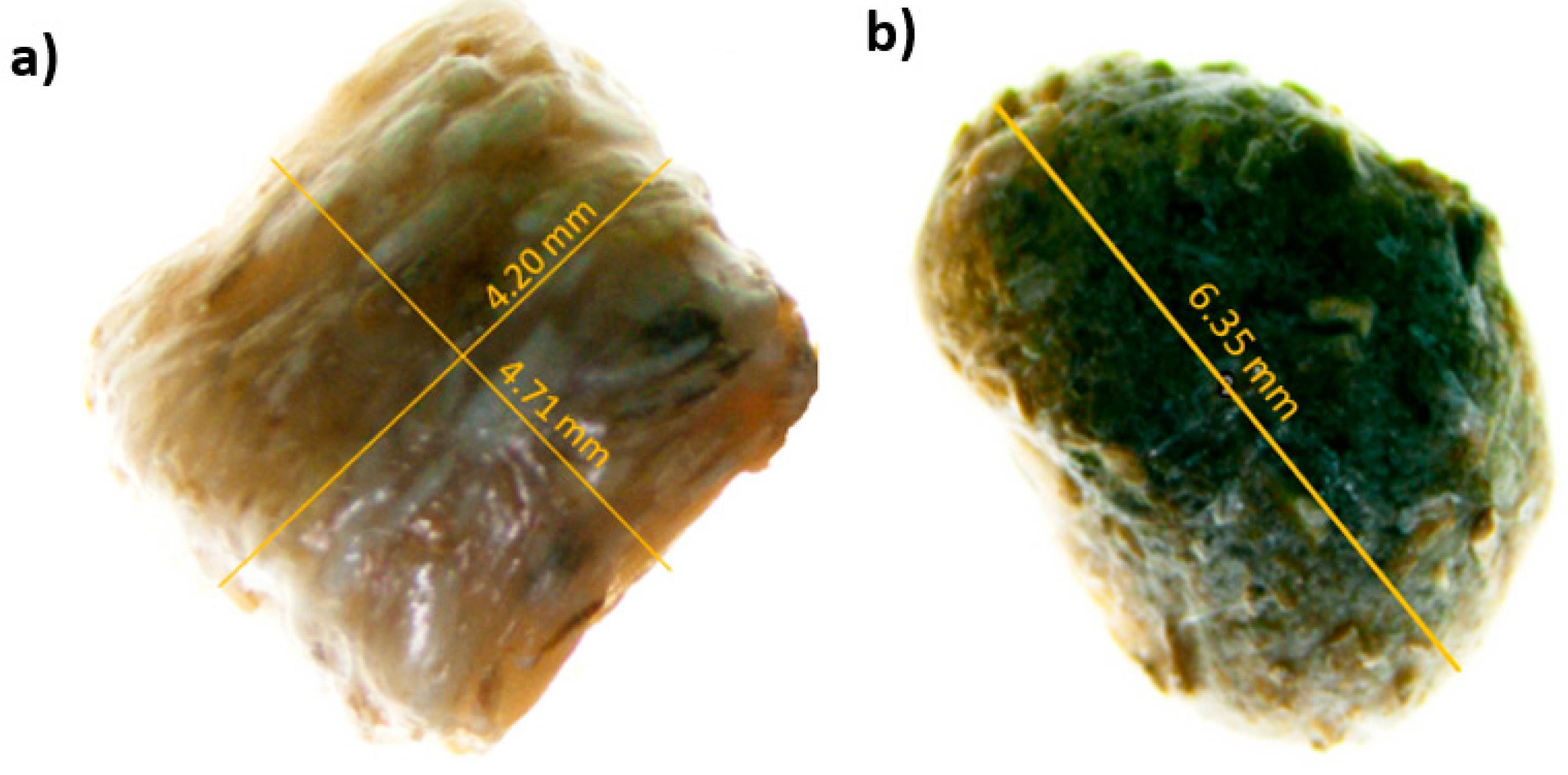
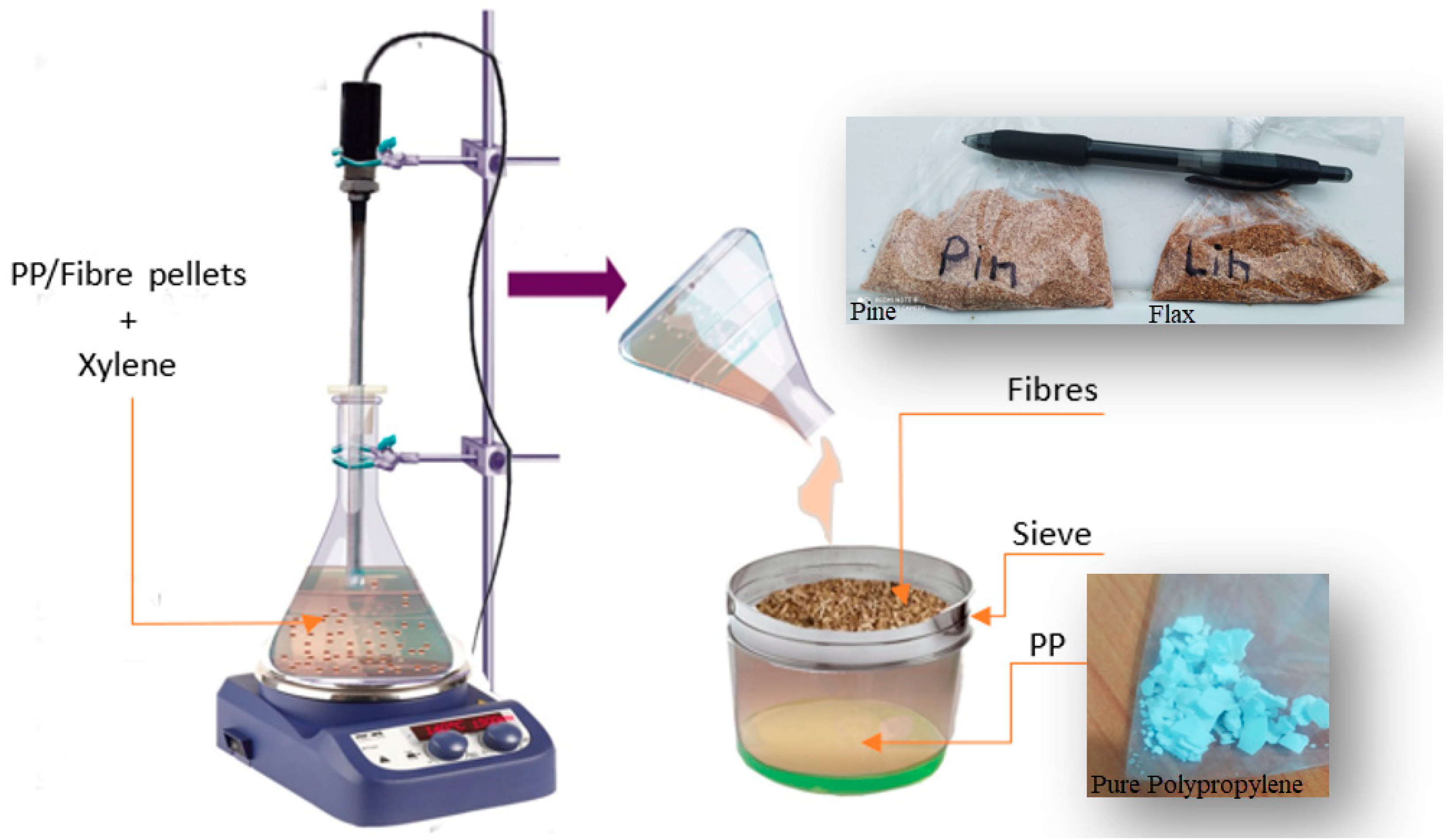
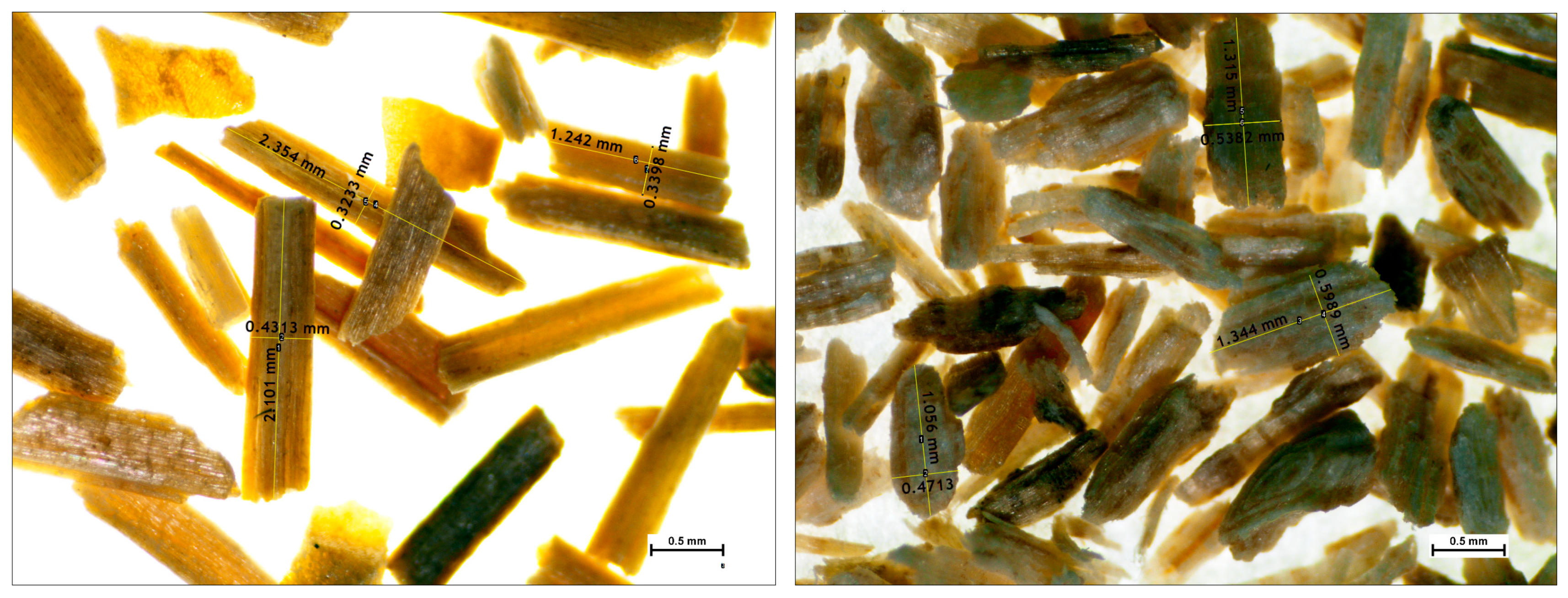
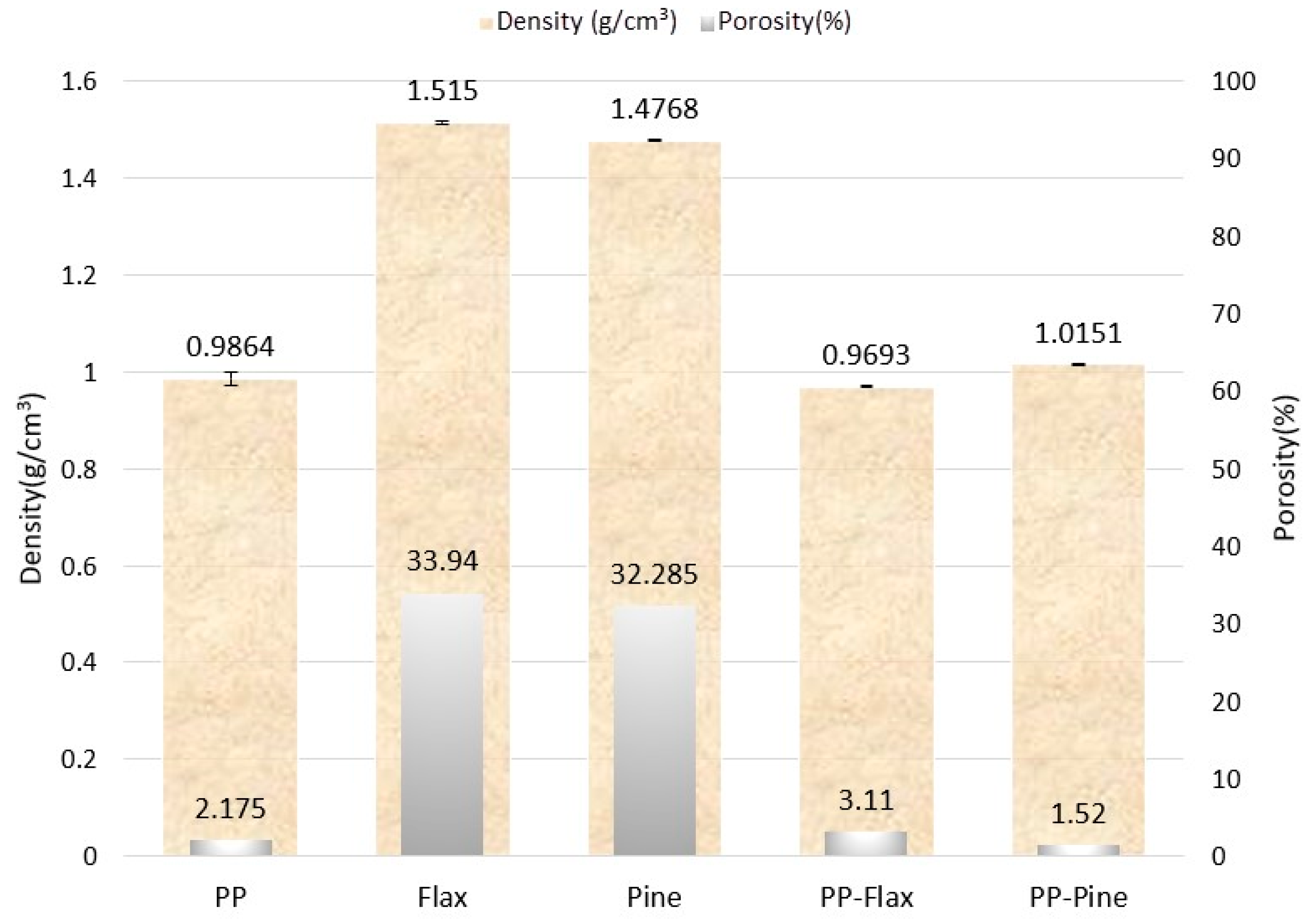
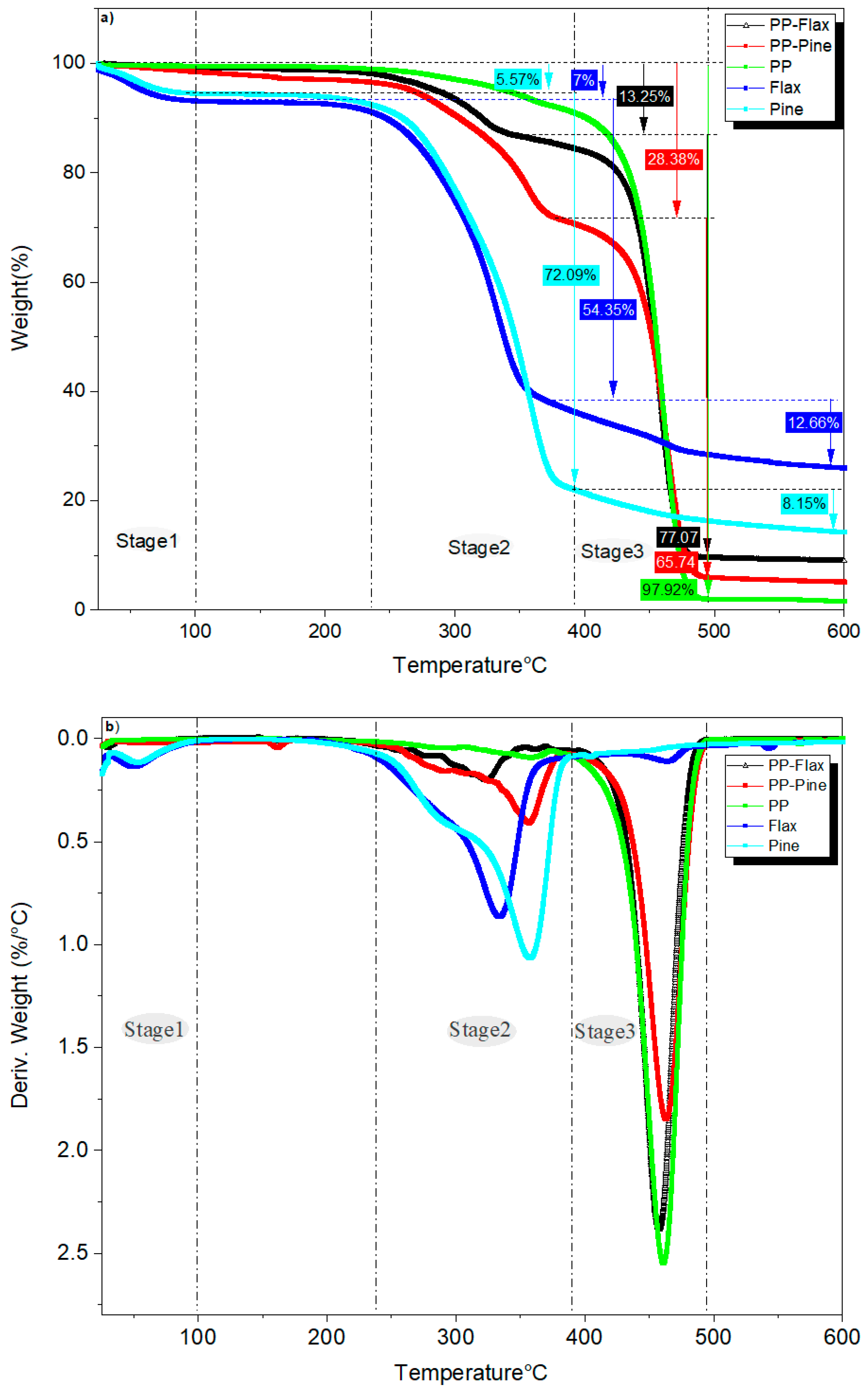

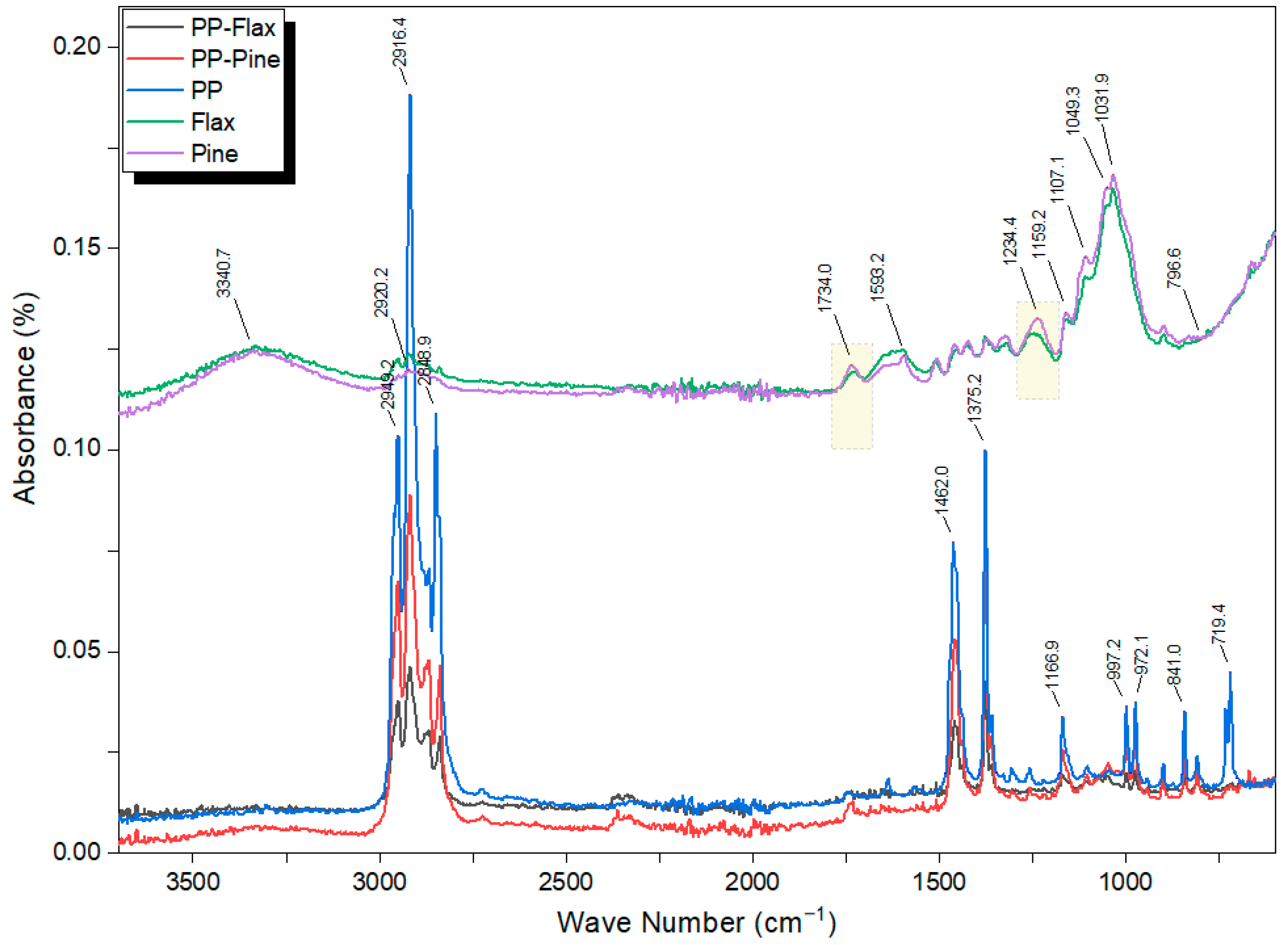
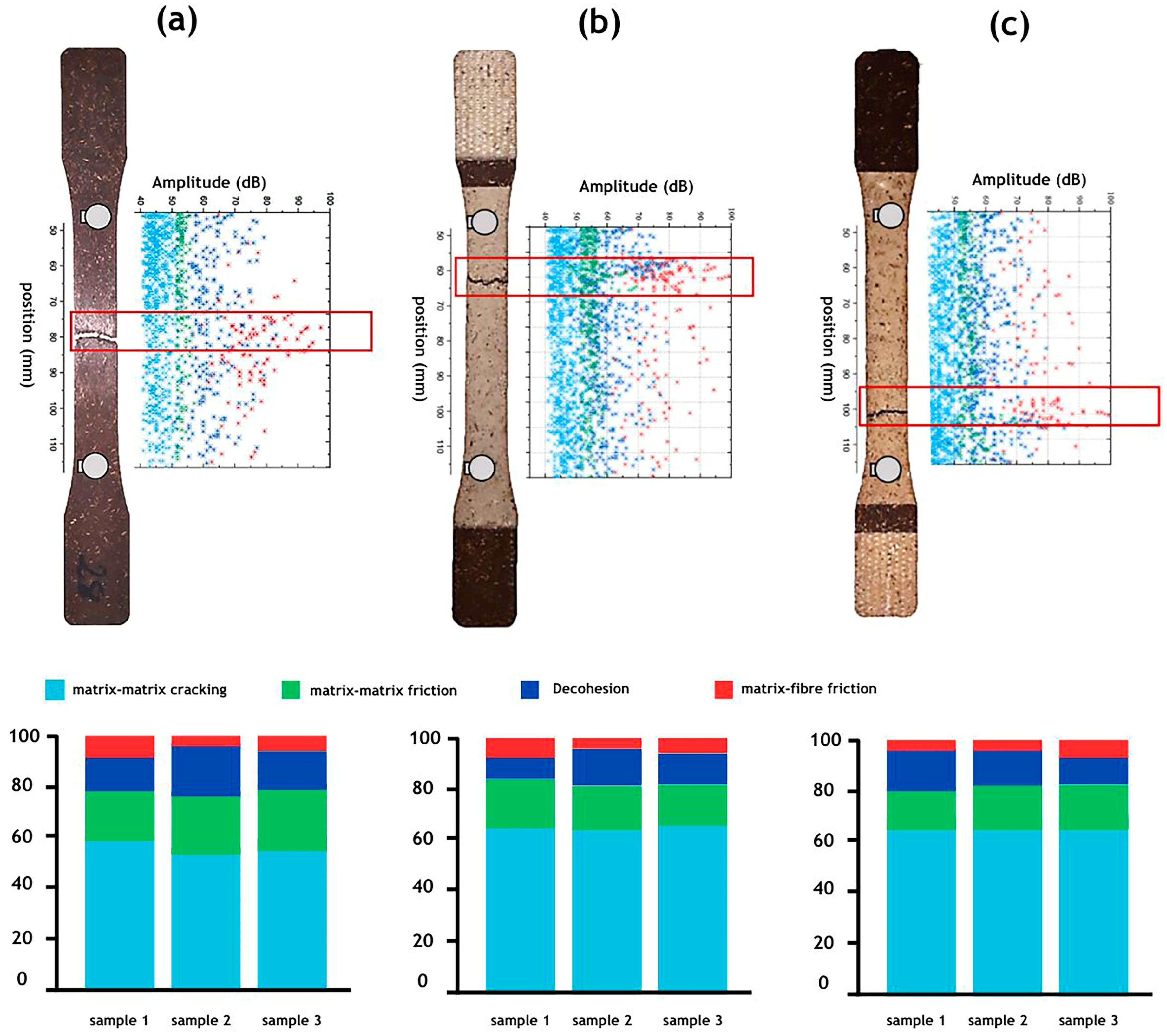
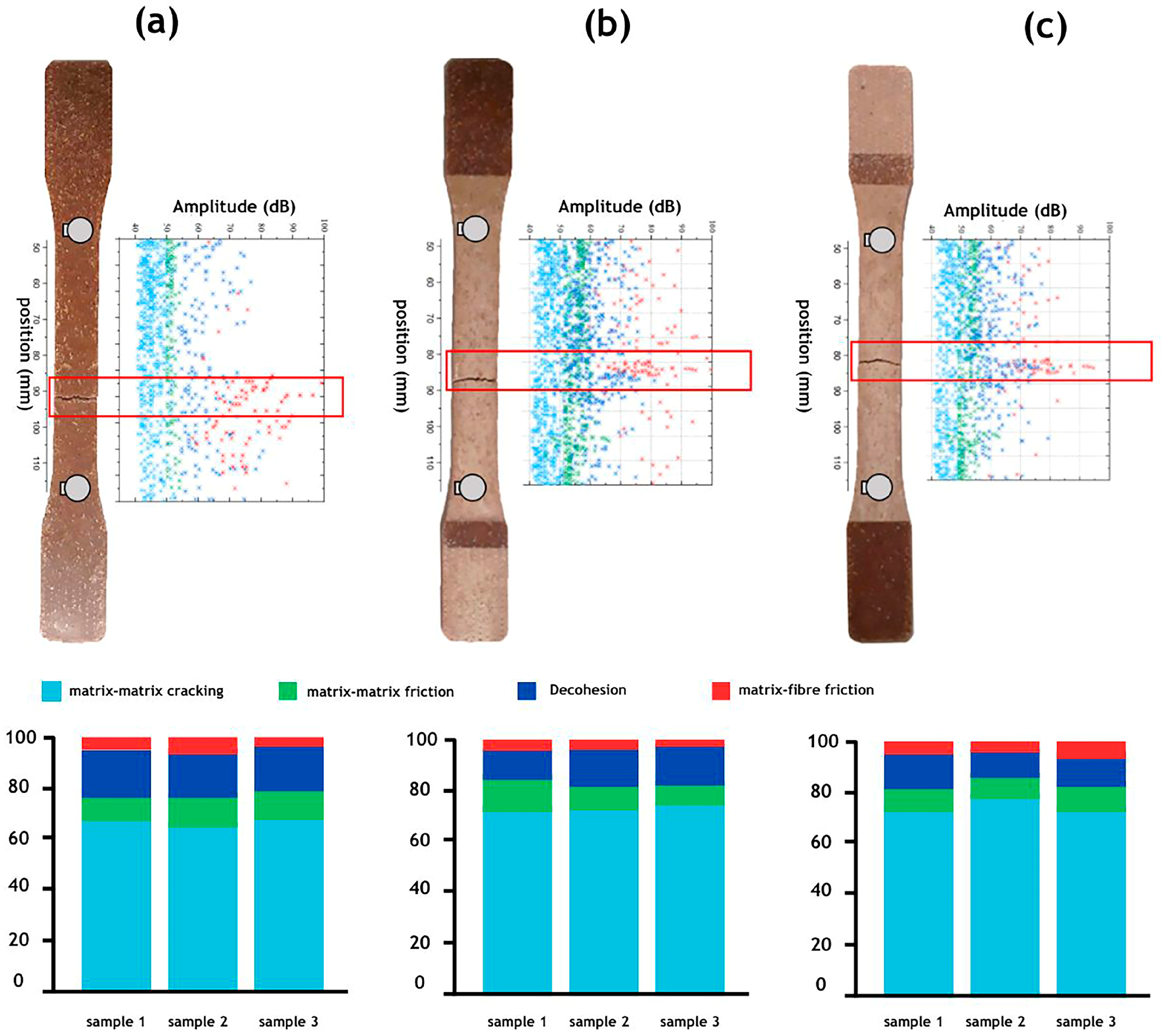
| Materials | Temperature (°C) | Type of Peak | Enthalpy (AH) (J/g) | Crystallinity (%) | ||
|---|---|---|---|---|---|---|
| Onset | Peak | Offset | ||||
| Flax | 25.2 | 41.2 | 100.5 | Endothermic | 566.16 | - |
| 189.9 | 249.1 | 302.3 | Endothermic | 63.74 | ||
| Pine | 25.6 | 41.5 | 103.3 | Endothermic | 576.6 | - |
| 203.2 | 252.9 | 305.3 | Endothermic | 41.47 | ||
| 311.2 | 363.4 | 393.2 | Endothermic | 96.84 | ||
| PP | 27.9 | 41.1 | 98.00 | Endothermic | 486.76 | - |
| 112.7 | 127.0 | 137.97 | Endothermic | 16.68 | - | |
| 145.9 | 162.0 | 177.97 | Endothermic | 18.34 (MPE) | 9 | |
| 361.7 | 462.1 | 504.05 | Endothermic | 662.12 | - | |
| PP–flax | 29.9 | 41.8 | 105.5 | Endothermic | 426.93 | - |
| 146.4 | 163.8 | 185.5 | Endothermic | 26.22 (MPE) | 12 | |
| 372.1 | 460.8 | 496.6 | Endothermic | 560.47 | - | |
| PP–pine | 25.40 | 40.96 | 93.36 | Endothermic | 433.73 | - |
| 117.9 | 128.3 | 140.9 | Endothermic | 12.81 | - | |
| 151.2 | 162.6 | 177.4 | Endothermic | 12.10 (MPE) | 6 | |
| 388.6 | 464.0 | 499.4 | Endothermic | 426.94 | - | |
Disclaimer/Publisher’s Note: The statements, opinions and data contained in all publications are solely those of the individual author(s) and contributor(s) and not of MDPI and/or the editor(s). MDPI and/or the editor(s) disclaim responsibility for any injury to people or property resulting from any ideas, methods, instructions or products referred to in the content. |
© 2024 by the authors. Licensee MDPI, Basel, Switzerland. This article is an open access article distributed under the terms and conditions of the Creative Commons Attribution (CC BY) license (https://creativecommons.org/licenses/by/4.0/).
Share and Cite
Belouadah, Z.; Nasri, K.; Toubal, L. The Effects of Lignin on the Thermal and Morphological Properties and Damage Mechanisms after UV Irradiation of Polypropylene Biocomposites Reinforced with Flax and Pine Fibres: Acoustic Emission Analysis. Materials 2024, 17, 2474. https://doi.org/10.3390/ma17112474
Belouadah Z, Nasri K, Toubal L. The Effects of Lignin on the Thermal and Morphological Properties and Damage Mechanisms after UV Irradiation of Polypropylene Biocomposites Reinforced with Flax and Pine Fibres: Acoustic Emission Analysis. Materials. 2024; 17(11):2474. https://doi.org/10.3390/ma17112474
Chicago/Turabian StyleBelouadah, Zouheyr, Khaled Nasri, and Lotfi Toubal. 2024. "The Effects of Lignin on the Thermal and Morphological Properties and Damage Mechanisms after UV Irradiation of Polypropylene Biocomposites Reinforced with Flax and Pine Fibres: Acoustic Emission Analysis" Materials 17, no. 11: 2474. https://doi.org/10.3390/ma17112474
APA StyleBelouadah, Z., Nasri, K., & Toubal, L. (2024). The Effects of Lignin on the Thermal and Morphological Properties and Damage Mechanisms after UV Irradiation of Polypropylene Biocomposites Reinforced with Flax and Pine Fibres: Acoustic Emission Analysis. Materials, 17(11), 2474. https://doi.org/10.3390/ma17112474






